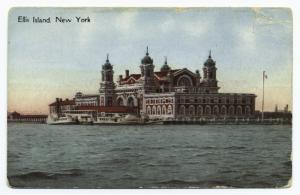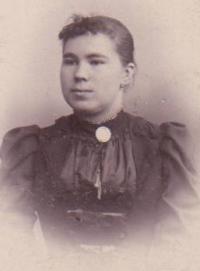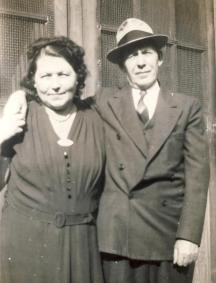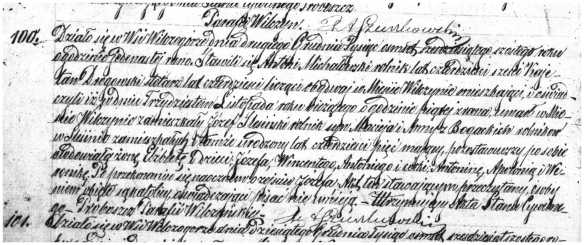Ever since my first transatlantic trip in 1985, I’ve been stricken with the travel bug. There is no cure. Symptoms include a desire to wander to far-away places, hopeless daydreaming, and a joy brought on by traipsing on planes and trains. I did not think my condition was genetic as no one else in my immediate family seems to have this disease. But then I realized that about a hundred years ago, my ancestors had the ultimate travel experience. It was no Grand Tour though… It certainly wasn’t a vacation to travel thousands of miles across the Atlantic Ocean to begin a brand new life. In most cases, they never returned to their homeland again or saw the family that stayed behind.

While the immigrant experience in itself is quite inspiring no matter who made the journey, I am especially fascinated by my female ancestors and relatives that made this trip-of-a-lifetime. In every instance they either traveled alone or with small children to meet their husbands or other family members who were already in the United States. I can only imagine what this experience was like.
First, the hard decision was made to pack up, leave their homes behind, and travel to a foreign land – not just temporarily, but most likely forever. I stressed over moving ten miles away from my childhood home! What were the conditions like in Germany or Poland/Russia that inspired these women to leave? Was the economy bad? Little or no chance of employment? What did they hear about America that made it seem better? How long did it take to afford the move across the pond?
The next difficult part of the journey was the separation that couples endured. If you were married, usually the husband made the journey first. Presumably it was necessary for the man to find housing and employment, and then save money to send for the rest of the family’s trip.
When it came time for the women to travel, the first part of the journey involved getting to the port. In my family, several ports were used including Hamburg and Bremen in Germany, Southampton and Liverpool in England, and Antwerp in Belgium. I don’t have any first-hand accounts of their lives or of their journeys to America, but I know that travel back then was not as quick and easy as it is today (TSA rules and flight delays notwithstanding, travel really is “easy” today by comparison). So it’s my guess that even this land-based part of the trip may have been complicated. Fortunately, the railways in Europe were probably as good as they are today. But, life was different. No one had cell phones to keep in touch up to the minute. There were no baby carriages, so toddlers walked and babies were carried. My guess is that the majority of immigrants came with one suitcase at most – travelers today probably take more for an overnight trip then our ancestors carried for the trip of their lives.
The time at sea wasn’t exactly a cruise ship experience! The vast majority of immigrants, including every one of my ancestors, came over in third class steerage on steamships. If the weather was good, folks could go up on deck to pass the time. The journey, at least during the years that my ancestors traveled, took about two weeks. After arriving through Ellis Island, not everyone was reunited with their families immediately. Today we complain about security or passport lines and slow baggage retrieval. Back then, the immigrants stood in line for processing. During the peak years that my ancestors came to the US, a busy port like New York at Ellis Island processed up to 5,000 immigrants a day! In addition to the processing time, occasionally immigrants were detained. If someone looked ill, they were kept for further examination. In some cases, the unlucky person or family was deported. Can you imagine finally arriving and you still can’t see your family? Or worse still, being told you can not enter the country?
Although these ladies weren’t travelers in the “pleasure travel” or vacation sense of the word, I find their stories to be amazing…even if they settled down in the US and never traveled more than ten miles for the rest of their lives. Here are some brief portraits of the courageous women travelers in my family:
1888 – Hilaire Bergmeister
Hilaire, my great-great-aunt, is my “premiere” female traveler both in terms of being the first as well as the gutsiest! She traveled to the US on the SS Friesland alone at the age of 23. She had no family here. That alone makes her journey truly impressive to me. I’ll write more about Hilaire and her life later this week for the next Carnival of Genealogy.

Marie Bergmeister, Munich, Germany, circa 1890-1900
1901 – Marie Bergmeister (nee Echerer)
My great-grandmother Marie is Hillaire’s sister-in-law, but they probably had never met until both were here in the US. Marie traveled from 13-27 June on the SS Kensington via Antwerp, which is 460 miles from her home in Pfaffenhofen an der Ilm, Germany. Marie was 26 when she made the journey with her 3-year-old daughter, Marie. They had not seen their husband and father, Joseph, for just over one year.
1903 – Wacława Zawodna (nee Slesinska)
My great-grandmother Wacława is my only ancestor to travel through the port of Philadelphia instead of Ellis Island. She sailed from Liverpool on the SS Westernland for two weeks in July. Just getting from Dobrosołowo, Poland to Liverpool was an amazing 1,100-mile trip! She was only 18 years old and traveled to meet her husband, Jozef Zawodny. He had been in the US for over a year, but the young couple had only just married weeks before he left Poland. One can imagine how anxious she was to see her new husband after such a long separation. Wacława would never see her parents again – parents who were quite unhappy with her marriage and apparently refused to communicate with her even by mail. She was the oldest daughter, and she would not see her four younger sisters for many years. In fact, when she left Poland, her youngest sister was only 2 years old!
1906 – Rosalia Piontkowska (nee Kizoweter)
Great-grandmother Rosalia gets extra credit in the “gutsy” category for traveling with her 3-year-old son, Jozef, and her 1-year-old daughter, Janina, on the SS Armenia from Hamburg to New York, arriving on 10 November. She wasn’t a young mother either at age 41, and she hadn’t seen her husband Jan for over six months. I have no photos of Rosalia, but her passenger list record describes her as 5’3″ with brown hair and blue eyes. I try to picture her juggling Janina and a suitcase while trying to hold on to her toddler at the same time! If that weren’t brave enough, the journey from Warsaw, Poland to Hamburg, Germany was about 540 miles!
1906 – Antonina Pater (nee Pluta)
The Pater family arrived in the US in stages. My 2nd great-grandmother Antonina, age 42, and two of her daughters, 18-year-old Regina and 2-year-old Victoria, arrived second, which was nearly 18 months after their husband and father Jozef settled here. She would have to wait nearly a year to see another daughter and three young sons, and it would be nearly three years before she would see her mother again. Antonina and her daughters traveled on the SS Blücher from Hamburg, about 520 miles from her home in Żyrardów. I have no photos of her or these daughters, but the passenger list offers descriptions. Antonina was 5’2 3/8″, she had a sallow complexion, brown hair, blue eyes, and a wrinkled forehead (as any mother separated from her children would have!). Regina was 5’3 1/2″, fair, with blond hair, gray eyes, and a round face, and little Victoria had her big sister’s coloring.

Frances and Paul Nieginski, Philadelphia, PA, circa 1940s
1907 – Franciszka Nieginski (nee Pater)
My great-great-aunt Franciszka (Frances) and her husband Pawel (Paul) were responsible for bringing my great-grandfather and his brothers to the US since their parents were already here. They traveled on the SS Grosser Kurfurst in August. Franciszka was only 20 herself, and she brought 17-year-old Wacław, 14-year-old Ludwik, and 12-year-old Stefan with her since they would not be allowed entry alone. Because Wacław suffered from some sort of illness (short left leg and a deformed chest according to the passenger list), the entire group was detained for two days for further examination, which must have been quite stressful to all.
1909 – Elizabeth Miller
My great-grandmother, known in her native language as Elżbieta Müller, was 18 when she made the long journey from Żyrardów, Poland, to New York on the SS President Grant. Not yet married, she traveled alone and met her brother, Emil. My only photo of her much older, but I’ve heard she was quite attractive in her youth. The list describes her as 4’11” with a fair complexion, light brown hair, and gray eyes. She would marry a slightly younger man, Ludwik (Louis) Pater, a little more than a year later. Both were from Zyrardow, but he came to the US almost two years before her trip.
1909 – Franciszka Pluta (nee Wojciechowska)
How I wish I had a photo of Franciszka! She is my 3rd great-grandmother, and the oldest ancestor to have made the journey to America at age 69. And she traveled alone! She is the mother of Antonina Pater, and she joins her daughter’s family after a 2-day wait in detention for a medical exam. They determined she was an “LPC” or Likely Public Charge, probably because of her age and/or health. The list describes her as 4’10”, limping, with dark hair, blue eyes, and a dark complexion. What an amazing journey for a woman her age! She lived with her daughter’s family until her death in April 1914.

Clockwise from top left: Jozefa/Josephine, Wacława/Laura, Marianna/Mary, Zofia/Sophie, and Janina/Jane, McKeesport, PA, circa late 1920s
1920 – The Slesinski Sisters
As mentioned above, Wacława Zawodna (nee Slesinska) had four sisters that came to the US. I haven’t yet located the arrival of Jozefa, but Marianna, Janina, and Zofia all arrived together on the SS Adriatic from Southampton in October 1920. The sisters were 24, 22, and 19 years old, and their parents had died the year before – within two days of each other on 30 December 1918 and 01 January 1919. They are coming to join their sister Jozefa and her husband in McKeesport, PA. Although they pass by big sister Wacława, who had been here for 17 years by then, the five later reconnected since I have photos of the group together.
So there you have it…some courageous travels of some amazing women. I remember the first thrill of traveling alone, the fear at being in a place where no one spoke my language, and the joyful excitement of setting off on a journey to a new place. The trip that these women made wasn’t for vacation, but was it thrilling, fearful, and joyous all at the same time? I’d like to think so, and I’d like to thank them for their inspiring courage to make that trip and begin a new life here in America.
For more information on the immigrant experience, see the following sites:











































